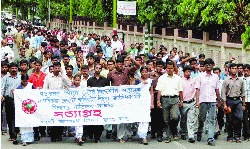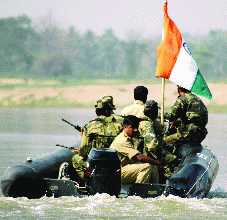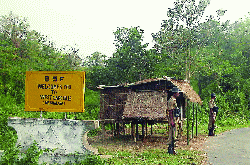Archives
Cover Story-The Bangladeshi Issue - A Resurgent Spectre
 Pakistani passport could contest elections in the State. The court even observed that Bangladeshis would soon become kingmakers in Assam and that the State government had failed to solve the problem. The observation was not certainly something that did not agitate the intellectual mind in Assam. During the author’s four year stay in Guwahati, the issue was mentioned, at times with rage and indignation, by many senior intellectuals.
Pakistani passport could contest elections in the State. The court even observed that Bangladeshis would soon become kingmakers in Assam and that the State government had failed to solve the problem. The observation was not certainly something that did not agitate the intellectual mind in Assam. During the author’s four year stay in Guwahati, the issue was mentioned, at times with rage and indignation, by many senior intellectuals.
However, the political regime has tended to look for quick fix solutions rather than addressing such issues with any element of seriousness. Within few days, on August 4, 2008 authorities in Assam rounded up Kamaluddin, handed him over to the Border Security Force (BSF) who pushed him back to Bangladesh under the cover of darkness through the border along village Maishashan in Karimganj district. It is not clear whether Kamaluddin will make an attempt to make a third time come back. It might not be too difficult a task.
Political patronage and the demands of real politick have made the makeover from migrant status to ‘legal citizens’ of the State relatively uncomplicated. Political leaders have not only prevented the existing machinery from identifying and deporting aliens, but have legalised their presence through instrumentalities like generous distribution of ration cards and even citizenship certificates. Successive regimes in Assam, be it the Asom Gana Parishad (AGP) which claims to have an avowed policy of protecting the Assamese from the onslaught of the illegal migrants, or the Congress, which is seen by many as having benefited from the presence of the migrants, have erred seriously in terms of tackling the presence of the Bangladeshis in Assam. Statistics show that between 1985 and 2005, a total of 12,846 persons were declared as foreigners by the tribunals under the Illegal Migrants (Determination by Tribunals) Act. Of these, only 1,547 could be deported. In 2005, the Supreme Court repealed the IM (DT) Act. Subsequently, between July 2005 and March 2008, a total of 1,205 persons were declared as foreigners. Only one of them was actually deported.
The High Court’s observation has re-fuelled the imaginations of many in Assam and many organisations have jumped into the fray to take advantage of the situation. The All Assam Students Union (AASU) has called for a boycott of the Bangladeshis. The AGP and the Bharatiya Janata Party (BJP) have accused the Congress of protecting the interests of foreign nationals The Congress Party, on its part, is bringing out a white paper on the situation.
Interestingly, the Kamaluddin episode resembles something that was the precursor to the Assam Agitation in the 1980s. A by-election called for in 1979 following the death of a Member of Parliament (MP) was to trigger-off the first organised anti-foreigner movement in Assam, and this, in fact, went on to become the immense mass uprising. The circumstances of the by-election provide interesting insights. The MP who passed away was Hiralal Patowari, representing the Mongoldoi parliamentary constituency in northern Assam. The Election Commission therefore ordered a fresh poll to fill the vacancy. Soon, officials started the exercise of revising the voters’ rolls for the Mongoldoi constituency. The exercise was reaching an end when the local electoral officer started receiving complaints that the names of many Bangladeshis had been included in the voters’ list. In several weeks, as many as 70,000 complaints were registered against illegal immigrants. A tribunal was set up by the state government to investigate the complaints. It upheld 45,000 complaints or sixty-four per cent of the cases out of a total electorate of 6,00,000. It is a different matter altogether that the Assam Agitation that culminated with the signing of the Assam Accord achieved virtually nothing in terms of detecting and deporting the migrants.
Migrants are also alleged to be responsible for the denudation of forest areas, for the encroachment of the living space of the locals, and for monopolising the service sector by undercutting local labour. It is, of course, a different matter that the Assamese have generally been disinclined towards manual labour. Additionally, it now increasingly being established that sections of the migrant population bring fundamentalist and overtly anti-Indian sentiments along with them; thus creating fertile grounds for the designs of Pakistan’s Inter Services Intelligence (ISI). Police sources reveal that Islamist insurgency in Assam has its genesis in the unabated migration from Bangladesh. Even though few would risk asserting a direct co-relation between Bangladeshi migration and the growth of Islamist insurgent groups in the State, the fact remains that it is the migrant inhabited areas that provide a steady recruitment ground for the organisations such as the Muslim United Liberation Tigers of Assam (MULTA) in Assam.
areas that provide a steady recruitment ground for the organisations such as the Muslim United Liberation Tigers of Assam (MULTA) in Assam.
The Bangladeshi Issue - A Resurgent Spectre page 2
-
The absolute impact of illegal migration in Assam, however, is political. Demographic movements are, of course, a fait accompli, with the State situated in close proximity to a region that is comparatively less attractive for its own population in terms of economic opportunities. Many proud Assamese would agree, albeit silently, that political power has slipped away from the hands of the ethnic Assamese over the years. It is noticeable that the Congress party in Assam, which remains the preferred political party for the minority community (the indigenous Muslims who are, according to one estimate, nearly 20 per cent of the State’s population), has systematically extended its sphere of influence over the immigrant Muslims as well. As a result, the Muslims of Assam have never felt the need to organise themselves into communal political groupings (the formation of the United Minorities Front in 1985 was a localised aberration and the whole experiment was a failure), unlike States like Kerala, where parties like the Muslim League have carved out a niche for themselves. ‘Vote bank’ politics has made Muslims in Assam (indigenous as well as illegal immigrants) more secure under a Congress regime. The enactment of the IM (DT) Act by the Congress Party at the centre in 1983 was essentially an attempt to protect its traditional vote bank from harassment and legitimate expulsion.
Muslims constitute nearly 30 per cent of the State’s population, and their support has had defining impact on electoral outcomes in the past. Estimates indicate that Muslims – including a large number of illegal migrants who have been fraudulently assisted in securing voting rights – dominate at least 40 of the State’s 126 Assembly Constituencies.
It remains to be seen what the present movement actually achieves. One such movement in the upper Assam districts, notably by the Chring Chapori Yuva Manch, which made news all over national media in 2005 due to its SMS campaign against the Bangladeshi nationals, lasted just over a month and led to the ouster of a few hundred people of the minority community, not all of whom were Bangladeshi nationals. The appeal by the Organisation to the Assamese people not to employ the Bangladeshis remained an impractical and uneconomical option and hence, found little acceptance among them.
It has been noted by many that migration from Bangladesh is primarily driven by economic factors and hence is simply unstoppable. Given the predictions of climate change, the rise in global temperatures and consequent rise of the sea level that will lead to a large scale displacement of the Bangladeshis, such pressures on the North
 East, especially on states such as Assam and Meghalaya are bound to increase. Periodic agitations by opportunistic organisations; in either of these two States primarily based on ‘no work to the foreigners’ campaign; are not simply going to create enough barriers for the migrants.
East, especially on states such as Assam and Meghalaya are bound to increase. Periodic agitations by opportunistic organisations; in either of these two States primarily based on ‘no work to the foreigners’ campaign; are not simply going to create enough barriers for the migrants.
Migration from Bangladesh and commentaries on it have tended to play on the psyche of the general public by invoking the fear of a silent and pre-planned demographic invasion from the other side of the border. There are enough additional commentaries which speak of an Islamic encirclement of the North East and a plan on the part of Bangladesh to take over the North East. Such assumptions, however, are not supported by any empirical research. Migration can have serious implications on the demography of a state, but it is certainly not a part of a ‘vicious’ and ‘organised’ machination on the part of anybody. Understanding this would help forming a course of action to deal with the problem.
Fencing of the India-Bangladesh border, for years has been hailed as a critical component of a policy that seeks to keep the unwanted migrants out. Given the limitations of such a policy, India’s achievement on that front has remained inadequate. As on December 31, 2007, 200 kilometres of the 263 kilometre Assam- Bangladesh border has been fenced under three phases. However, vast stretches along 149 kilometres of fencing erected during the first phase has already been damaged and provide little resistance to the people who want to cross over. In addition, several reports have indicated the ease with migrants have crossed over by greasing the palms of the border guards.
Assam will have to think seriously in terms of managing the presence of the migrants. It has to recognise that the State will continue to attract migrants from Bangladesh the scale of which will simply increase in the future. There is thus a need for a system that ensures that migrants remain aliens and do not become an integral part of the Assamese polity. The current agitations do not seem to address these critical issues.
Bibhu Prasad Routray

